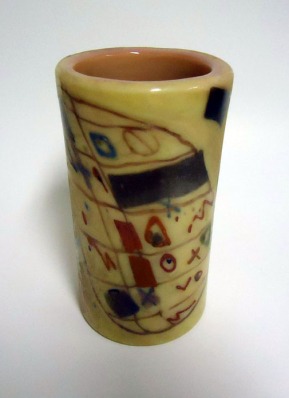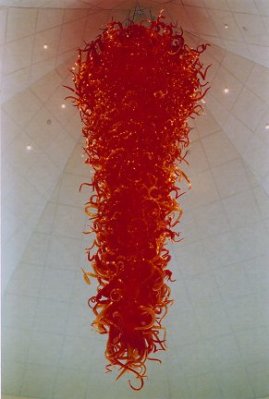 Possibly a student work made while Chihuly was making the “Navajo Blanket Cylinder” series, this work was quickly discredited as an authentic Chihuly by Kate Elliott, who was one of the artists involved in the authentic groundbreaking series.
Possibly a student work made while Chihuly was making the “Navajo Blanket Cylinder” series, this work was quickly discredited as an authentic Chihuly by Kate Elliott, who was one of the artists involved in the authentic groundbreaking series.
On June 19th, a 35-year-old Renton, Washington, resident named Michael Little plead guilty in federal court to wire fraud in connection with “his scheme to advertise and sell fake Chihuly artwork,” according to U.S. Attorney Jenny A. Durkan in an F.B.I. announcement. Little admitted he bought “generic glasswork and artwork over the Internet” and resold it, claiming that it was authentic Dale Chihuly, and making “at least $40,000” for counterfeit sales between 2011 and 2013, according to the release. Citing the October 4, 2013 sentencing date, investigators in the case declined to comment on details until after the legal proceedings were complete, but the appraiser who helped identify the works as fakes has shared some of the story with The GLASS Quarterly Hot Sheet to help alert others to the market in counterfeit glass artwork.
Appraiser and independent art dealer Kate Elliott has seen plenty of Chihuly copies—works in a similar vein but signed by other artists—but never had laid eyes on an actual fake being passed off as Chihuly’s own work. She was first contacted by a very bold Little in January of this year, who emailed her to say he was working to authenticate a work of Chihuly’s that had been in his family and had recently been sold because it was going to be donated to a museum. The work had been purchased by a retired air force pilot in his 70s who had been investing his modest life savings in quickly building up a Chihuly collection with plans to donate it to the local museum in Spokane. “He knew nothing about buying art,” says Elliott, who feels compassion for the victim of Little’s scam.
 Dale Chihuly’s 1995 work Gonzaga Red Chandelier at the Jundt Museum in Spokane, Washington, inspired a local resident to quickly amass a Chihuly collection to donate to the museum, but he fell prey to an admitted counterfeiter instead.
Dale Chihuly’s 1995 work Gonzaga Red Chandelier at the Jundt Museum in Spokane, Washington, inspired a local resident to quickly amass a Chihuly collection to donate to the museum, but he fell prey to an admitted counterfeiter instead.
Elliott doesn’t doubt the genuine enthusiasm buyer James Coombes had felt after seeing the Chihuly Gonzaga Red Chandelier (1995) chandelier at the Jundt Art Museum in Spokane, and his sincere desire to help the museum acquire more. Elliott says Coombes was so moved by the work that incorporates neon and illuminates at dusk that he wanted to make sure the institution had a fuller representation of Chihuly’s oeuvre, and set about quickly building up a collection to donate. (Contacted by the Hot Sheet, Coombes declined to comment until the sentencing phase of the case was completed.) Elliott says the novice collector purchased over $20,000 of counterfeit works before she was consulted by Little to authenticate a “Red Venetian” she dismissed out-of-hand for its “bad blowing, bad flowers, wrong proportions, and clunkiness.”
According to Elliott, Little had been using a Dremel to sign Chihuly’s name to generic blown glass works he found “at flea markets and estate sales,” as well as Chihuly lookalikes made by Asian companies in the 1980s. She speculates that Coombes’s expressions of interest in acquiring drawings may have inspired Little to begin making his own poor facsimiles which he signed with Chihuly’s name and tried to pass off as authentic. “He probably figured he could do those drawings himself,” says Elliott dismissively. “They are pretty terrible.”
 This drawing was purported to be by Dale Chihuly but was quickly identified as a fake by appraiser Kate Elliott.
This drawing was purported to be by Dale Chihuly but was quickly identified as a fake by appraiser Kate Elliott.
The one thing Elliott does give Little credit for is his research, calling him “pretty clever” for some of his subterfuge. “I think he had the books and read the chronologies, and knew the stories is my guess.” She says that when agents went into Little’s house to search for evidence, they found “a Chihuly signature rubber stamp, as well as a stamp with the old Northlake Way address.”
Elliott wants to alert other possible victims of Little, who first connected with Coombes through an EBay sale, because they might want to add their names to a restitution list being compiled by investigators. She also wants to help would-be purchasers of questionable Chihuly work to identify fakes before they bid on or pay for them.
“Generally, if somebody comes to me and says there’s a piece on EBay, and I can tell within a few minutes, I don’t charge them. I just tell them not to buy it,” says Elliott, who is regularly consulted for Chihuly authentications. She is also working with the Appraisers Association of America to update the exam for Studio Glass.
—Andrew Page


